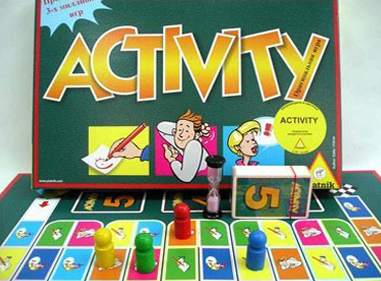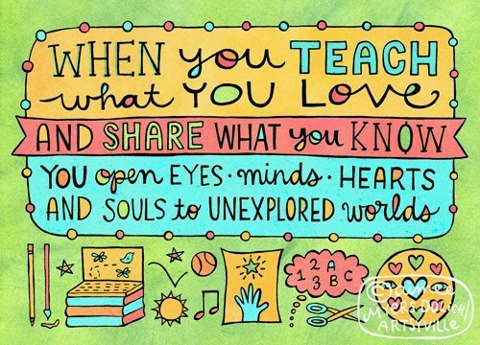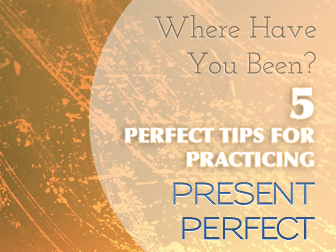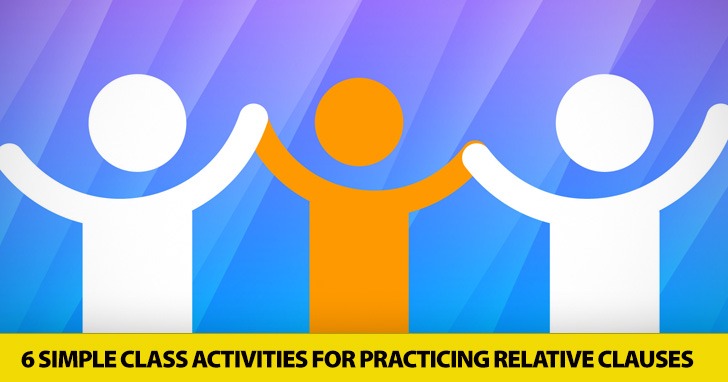Activities, games
Activities
- Superlatives
Activity: The coldest place I’ve been to
The superlative can regularly go with the present perfect (as in The best film I’ve ever seen was…). You could use this sentence stem to make a questionnaire. Make a worksheet with several examples. Here are some based around the theme of ‘weather’.
-
The coldest place I’ve been to was…
-
The hottest place I’ve ever visited was…
-
The worst storm I’ve ever seen was in…
-
The strangest weather I’ve ever experienced was…
Put students in pairs and tell them to interview their partner. To do this they must make questions, e.g. What’s the worst storm you’ve ever seen? They can also ask follow-up questions to find out more information. Do feedback on this as a whole class. Other thematic questionnaires of this kind could be:
Emotional experiences
- The most frightened I’ve ever been…
- The happiest moment I’ve ever had…
- The most nervous I’ve ever been…
Musical experiences(better with teens):
- The best concert I’ve ever been to…
- The worst song I’ve ever heard…
- The longest time I’ve ever danced…
- The best CD I’ve ever bought…
Places in your life
- The most dangerous place I’ve been in…
- The cheapest restaurant I’ve eaten in…
- The most boring town I’ve ever visited…
Activity: Award ceremony
You can also practise superlatives by organizing a class awards ceremony. Have awards for different categories:
• the student with the nicest smile
• the friendliest student
• the hardest working student
• the earliest student
• the best-dressed student
• the most talkative student
• the quietest student etc. (try to have only nice categories!)
You could either decide on the winners yourself or put the awards to a secret vote. Make sure that everybody gets an award for something (meaning that if you have 20 plus students you might have to have more than one recipient for an award). Make the awards on little stars. Hold a ceremony in which you distribute them to great fanfare. This activity works best at the end of the year, or the end of a Anchor Point:bottomterm.
You can also ask your students to find out:
Examples:

the driest desert
the biggest planet
the smallest planet
the smallest animal
the oldest person
the largest continent
the smallest continent
the tallest building
the longest river
-
Conditionals
Two tasks for conversation concerning the 2nd conditional. In the first part, students have to answer what they would do in the given imaginary situations.
Example: If you were invited to a fancy dinner with the president or a celebrity, who would you choose and why?
In the other part (starting with the idiom "to be in someone's shoes"), students deal with a list of their friend's problems and have to make up sentences stating what they would do.
Example: “My friends have no time for me.” (Answer starting with "If I were you, I'd...)
WHAT IF…
- If you were planning a big party for all your friends, and had all the money you needed, what would you have at the party ?
- If you were planning a party on a very small budget, what would you do to make it a great party?
- Food?
- Entertainment?
- Extras {like baby sitting}?
- If you were invited to a fancy dinner with the president or a celebrity, who would you choose and why?
- If you could have any job in the world, what would you like to do and why?
- If you were a rich person, where would you go for the next holiday?
IF I WERE YOU…
Your friend has many problems. Think about what you would do if you were “in their shoes”:
“I have no boyfriend.”
“I’m fed up with my job.”
“I can’t get to sleep at night but I am sleepy in the afternoon.”
“My family doesn’t understand me.”
“My neighbours are too noisy.”
“My friends have no time for me.”
“I’m fat and ugly.”
“My children are naughty and spoilt.”
- Where Have You Been? 5 Perfect Tips for Practicing Present Perfect

Present Perfect tense is a big turning point in a student’s language learning.
Once they have gotten to this grammar point, they have mastered a lot and are moving into more and more complex grammatical structures and tenses. That being said, teaching Present Perfect tense can be one of the most challenging and intimidating grammar points to refine. Follow these 5 perfect tips for practicing Present Perfect tense, and your students will glide through this transition with ease.
How to Teach Present Perfect: 5 Perfect Tips
-
Use Timelines to Stress the Uses
Timelines are a great visual when introducing the different uses for Present Perfect. One of the best things about them is once you introduce them, you can continue to refer back to them and make it a point to have students do a timeline when they are struggling. It is one of the best ways to show the differences in usage that are usually so slight it can be hard to concretely define. A timeline shows the tense in a picture format for you, and once students get used to seeing them, they will begin to reference them for this point and other more advanced tenses. Be sure to provide several examples with your timelines, and using different colored markers will help accentuate your point. Also, timelines should always have a marker for now. Here are some examples of timelines that display their uses for Present Perfect tense.
The present perfect is used to discuss events that have just been completed at the moment of speaking:
I have just finished my homework:
It is often used to suggest that a past action still has an effect upon something happening in the present.
He has been in a car accident. (So now he is in the hospital)
It is often used to discuss events that have been happening over a period of time, but aren't finished yet.
Mary has worked as a teacher for 25 years. -
Compare to Past Tense
The biggest issue students will have is the big decision between using Past tense and Present Perfect tenses. They will need constant comparisons, and the language you use will also help them to analyze what tense they need. There are lots of activities where students need to use both tenses accurately, and you can take that one step further by asking them to tell you why they have made which choice. Past tense is only used to express actions that are completed in the past with a time marker. That’s it. Present Perfect tense has several uses depending upon what you are trying to express. You can compare sentences and discuss how the meaning has changed with the tense choice. You may also want to discuss the time markers associated with each tense. Examples to analyze:
I went to school yesterday. I ate dinner late last night. I have been at school since 7 a.m. I have already eaten dinner tonight. -
Have You Ever….?
‘Have you ever done something’ is my favorite way to introduce and review Present Perfect tense. It can be used over and over again, in different formats, with different experiences. It also creates a natural way in which to use the tense and again offers some distinction between how it is different from using past tense. This is also a good way to show the negative uses and short answers. Here are some examples:
Have you ever been to India? Yes I have. No I haven’t.
Have you ever eaten sushi? No, I haven’t ever eaten sushi. No, never.
Have you ever been angry at your brother? I sure have.The possibilities for this activity are endless, and you can use worksheets, do mingling activities or do simple Q and A in rounds.
-
Yet, For, and Since
The time markers for Present Perfect tense are very important and need not be overlooked. Yet, for and since can confuse learners, so provide good examples for each usage where it applies.
- Yet is used to talk about an action that isn’t completed, but it will be soon.
I haven’t eaten lunch yet. (this implies that you will do so shortly).
I haven’t seen John yet today. - For is used to express the length of an activity
I have studied for 10 years.
I have worked for 2 hours so far. - Since is used to express the specific time an activity start
I have been a teacher since 1995
I haven’t written a letter since last year.
There are a lot of ways to practice this with conversational activities or with fill in the blanks.
- Yet is used to talk about an action that isn’t completed, but it will be soon.
-
Vary the Activities
There are numerous ways in which to practice Present Perfect tense, and this is in part to its different uses. You’ll want to take the tense step-by-step and introduce one usage at a time and then practice it. Build upon that usage and introduce the next usage. Over a matter of weeks, you can practice the tense by providing a variety of activities that include conversation, writing, discussion, Q and A, and grammatical exercises. Use your creativity and incorporate activities that practice the tense as a whole when students are ready.
Providing a lot of examples and repetition may be necessary when you approach Present Perfect tense.
Take it in stride and move at the students’ pace. You may also be surprised by how many challenging grammatical questions they will pose to you. Do your homework and make sure you have a firm understanding of Present Perfect tense. Using these 5 tips for practicing Present Perfect tense will deliver great results.
From site:busyteacher.org
-
6 Simple Class Activities for Practicing Relative Clauses
-
The Longest Sentence
How much do your students know about world-famous people? You might find out in this simple game which requires students to use relative clauses. In each round, two students will face off to find out who knows more information about a given person. Have the youngest person of the two go first and make a simple statement about a famous person. (For example, Albert Einstein was a scientist.) The next person must then add a piece of information to the sentence (using a relative clause) without changing what the first person said. (For example, Albert Einstein, who discovered the theory of relativity, was a scientist.) Play goes back to the first person who must add another piece of information to the sentence, and so on. When one player can no longer add a true piece of information to the sentence, the other person scores a point. If you like, divide your class into two teams and have one person from each team come to the front of the room each round. You can play this game orally or in writing.
-
Puzzle It Out
Help your students review the structure of sentences containing relative clauses with this hands on activity. Write several sentences using relative clauses in the middle. Then cut apart your sentences into three pieces – the beginning of the sentences, the relative clauses, and the end of the sentences. Shuffle all the pieces together and give them to a group of three or four students. They must then work together to assemble each of the sentences correctly with the pieces you have given them using context clues.
-
Chain Writing
You can have your students work together to write a funny story in this pass the paper activity. Have each person in your class start with a blank piece of paper. They will write one sentence on the paper that begins with the following: It was the day that… They will then complete the sentence, fold over the top of the paper, and then pass it to the next person. That person completes this sentence: There was a girl/boy who… They then fold over the top of the paper and pass it to a third person. That person finishes this sentence: She met a girl/boy who…
When the fourth person gets the paper, they finished this sentence: They had to defeat a monster that… The fifth and final person finishes this sentence: The outcome was something that…. When all five people have finished their sentences, have them give the papers to you. You will then unfold each paper and read the completed story. Your students are sure to get a laugh from these silly, multi-author stories.
-
Clues for You
In this game, students will give clues to an object as the class tries to guess which object it is. Divide your class into two teams. Have each team take turns choosing an object in the room to give clues about. Each clue should start with, “This is something that/which…” Each team will give three clues for its chosen object. If the other team is able to guess the object after just one clue, they score three points. If they need two clues to identify the object, they score two points. After three clues, they only score one point. If they are unable to guess the object after three clues, they score zero. Play until one team reaches twelve points.
-
It’s All Balderdash
Balderdash, by definition, means a lot of nonsense. It also happens to be a board game which is great fun to play in class. If you don’t have the game itself, you can play this modified version, which will give your students a chance to practice using relative clauses. Start by printing off a list of unusual holidays and observances that your students will probably not be familiar with. Your entries should include the date and the reason for the observance. Then cut your list into small slips of paper and put them into a hat. Have students draw one from the hat without showing it to their classmates. They will then use that slip to write three sentences about that date. One of the sentences should say the date and what the true observance is. The other two sentences should say the date and give false observances. For example, one person’s sentences might read as follows:
July 4th is the day that Americans drink and wear green.
July 4th is the day that Americans celebrate their independence.
July 4th is the day when Americans remember their deceased loved ones.Each student then takes turns reading their sentences to the class. The rest of the students try decide which statement is true.
-
Apples to Apples
This simple game is popular with players of all ages. In the game, each person gets five cards with random words on them which they must link to another random word logically. You can make your own modified version of the game by writing vocabulary words and common English words on index cards. (The more cards you have for each group of three to four players, the better. You can even have students make their own cards before starting the game.) Have groups shuffle their cards and then deal five to each person in the group. On a player’s turn, he lays one of his cards face up on the table. The other players must then choose one of the cards in their hands that they think best connects with the one their classmate played. Once everyone has laid down their cards, players take turns explaining the connections between the cards using relative clauses. For example, if I had the cards holiday and mug, I might give this explanation: People drink mugs of eggnog on the winter holiday which is Christmas. The person who played the first card chooses which connection he likes best, and the person who made it scores a point. Keep playing until everyone has had at least one opportunity to lay down the first card in the round or until one player scores five points.
From site: busyteacher.org

Загадки, приведенные ниже, можно с успехом использовать для так называемых "Yes-Or-No Games". Ведущий рассказывает короткую историю (часто детективного характера) с непонятным завершением, а участники игры, в свою очередь, задают ему наводящие вопросы, требующие ответа "да" или "нет", постепенно приближаясь к разгадке. Подобные игры являются весьма эффективным talk-тренажером (правда, не для ведущего), так что советуем вам не переключаться на русский язык в процессе игры. Если же вам лень задавать вопросы, можете попробовать отгадать эти загадки "с первого захода". (Для того, чтобы увидеть правильный ответ, выделите скрытый текст.)
A Man In The Elevator
A man lives on the tenth floor of a building. Every day he takes the elevator to go down to the ground floor to go to work or to go shopping. When he returns he takes the elevator to the seventh floor and walks up the stairs to reach his apartment on the tenth floor. He hates walking so why does he do it? (Одна из самых известных классических загадок подобного рода. Несмотря на то, что "подогнать" под нее можно несколько ответов, только "канонический ответ" считается верным.)
[ The man is a dwarf. ]
A Man Who Hanged Himself
There is a large wooden barn, which is completely empty except for a dead man hanging on the central rafter. The rope around his neck is ten feet long and his feet are three feet above the ground. The nearest wall is 20 feet away from the man. It is not possible to climb up the walls or along the rafters. The man hanged himself. How did he do it?
[ He climbed on a block of ice, which has melted. ]
Anthony and Cleopatra
Anthony and Cleopatra are lying dead on the floor of a villa in Egypt. Nearby is a broken bowl. There is no mark on either of their bodies and they were not poisoned. How did they die?
[ Anthony and Cleopatra were goldfish whose bowl was knocked over by a clumsy dog. ]
Heaven
A man died and went to Heaven. There were thousands of other people there. They were all naked and all looked as they did at the age of 21. He looked around to see if there was anyone he recognized. He saw a couple and he knew immediately that they were Adam and Eve. How did he know?
[ Adam and Eve were the only people without navels. They were not born by women. ]
Push That Car
A man pushed his car. He stopped when he reached a hotel at which point he knew he was bankrupt. Why?
[ He was playing Monopoly. ]
From site:http://www.fluent-english.ru
7 Best Games for Vocabulary Class
-
Charades
Write vocabulary words on individual index cards. Break your class into two teams, and have one individual from each team act out the same word. The team to correctly guess the word first scores a point.
-
Pictionary
Write vocabulary words on individual index cards or use your set from charades. Break your class into two teams, and one individual from each team draws a picture on the board. Drawers cannot use letters numbers or symbols in their drawings. The first team to guess the word correctly scores a point.
-
Memory
Create your own memory game using vocabulary words. Write each word on individual index cards. For each existing card, make a matching card with the definition, a synonym or an antonym. Students shuffle the cards and arrange them all face down on a table. Students take turns flipping over two cards. If the cards make a set, the student keeps the cards and takes an additional turn. The person with the most cards at the end of the game wins.
-
Modified Catch Phrase
Write each vocabulary word on an individual index card. Students sit in a circle with a timer set for a random amount of time (3-8 minutes works well). Shuffle the cards and give the deck to the first person in the circle. That person draws a card and tries to get his classmates to guess the word by giving verbal clues. He cannot say the word or any part of the word. When someone guesses the word, he passes the stack to the next person who takes a turn with another word. The person holding the stack of cards when the timer goes off loses.
-
Scattergories
Choose ten categories with your students or before class starts (e.g. types of pets, city names, sports, items in a kitchen, etc.). Use an alphabet die to determine the letter for each round of play. Set a timer for three minutes, and students must think of one word for each category that begins with that round’s letter. Students score one point per word, and the person with the most points at the end of three rounds is the winner.
-
The Dictionary Game
Choose an unusual word from the dictionary and spell it for your students. Each person creates a fictional definition for the word and writes it on an index card. You write the actual definition on another index card. Collect and shuffle the cards, and then read all the definitions. Students must try to guess which definition is the real one.
-
A-Z Pictures
Using a picture with many elements (I-Spy books work great), students attempt to find an object in the picture that begins with each of the letters A through Z. After about five minutes, students compare answers. The person with the most correct answers wins the round.

